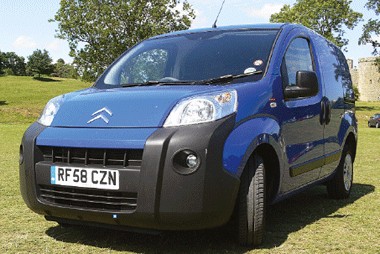Review
Experts reckon that a busy delivery driver uses the clutch around 5,000 times a day. That’s a lot of wear and tear on the clutch mechanism and a fair amount of stress on the driver’s left leg.
Until recently, such minor irritations were accepted as part of a van driver’s life, but increasingly we are seeing new models offering a halfway house between manual and full automatic which take care of such problems.
Latest to join these ranks is the Citroën Nemo, which is now being offered in SensoDrive format.
This van was highly commended in the green van (conventional fuel) category at the Fleet Van Awards.
The SensoDrive version gives the Nemo a new string to its bow that, while it may not get fleet buyers stampeding to the doors of Citroën dealers, will certainly enhance its already enviable reputation.
The downside is that this gearbox will cost £400 extra over the manual but, on the plus side, Citroën reckons that in real-life conditions, it will probably return around 3% better fuel economy than the manual.
And, of course, there’s the leg-relieving benefit mentioned earlier to be taken into consideration.
The economy benefits may be a surprise to some who normally consider that an automatic uses more fuel than a manual.
But the point is, this van is not an automatic.
It’s described as an automated manual, which means that technology decides when to make changes and does so in a more efficient manner than you or I could.
For those who really hate the thought of not changing gear by hand, the lever can be nudged to the left and ‘paddled’ up and down, although for the life of me I can’t imagine a reason why anyone would want to do that.
During my test week I simply shoved it in the ‘A’ position and left it there, unless I wanted to go backwards, of course.
The SensoDrive comes with a 1.4 HDi common rail diesel unit that pumps out 70bhp at 4,000rpm and 118lb-ft of torque at 1,750rpm.
With a gross vehicle weight of 1,700kg, it offers a payload of 610kg and a load volume of 2.5 cubic metres. Price is £10,645 ex-VAT.
Behind the wheel
Before we start, I have to admit that I’m totally biased towards this van and its twin brothers the Peugeot Bipper and Fiat Fiorino.
It was designed as an urban delivery vehicle to winkle into little corners and city back streets and as such it’s tremedously easy to drive with light controls.
It’s a little like Dr Who’s Tardis. It doesn’t look very big from the outside but offers nearly as big a load area as the old Citroën Berlingo while still having bags of legroom.
And the driver’s seat is superbly comfortable too – not one of those half-size affairs we see in certain models.
How did the designers manage that? Search me, but they deserve a big round of applause.
Our test vehicle had the folding passenger seat that goes right down into the floor, which means extra long loads can be carried.
I have quite got into the way of driving automatic vehicles and I choose them every time when I can. Full autos nowadays offer completely seamless changes but it must be said that the Nemo ‘halfway house’ box does show its rough side sometimes. It can be annoying but I got used it during my test week.
I was also pleased to discover that the Citroën press office had added air-conditioning to this van. It does cost £550 though, so I’d guess most fleet drivers won’t get it.
They also won’t get ESP traction control as, sadly, Citroën doesn’t offer it even as an option.
Verdict
Before reaching a verdict on a van we always ask ourselves: “Would we be happy as fleet drivers to use this vehicle?”
The answer in this case is a definite “yes”. Its cheeky looks please, its driver’s seat is superb for a such a small van and its road manners are pleasing in the extreme.
















